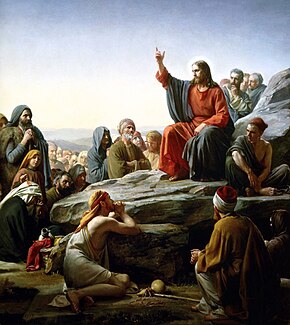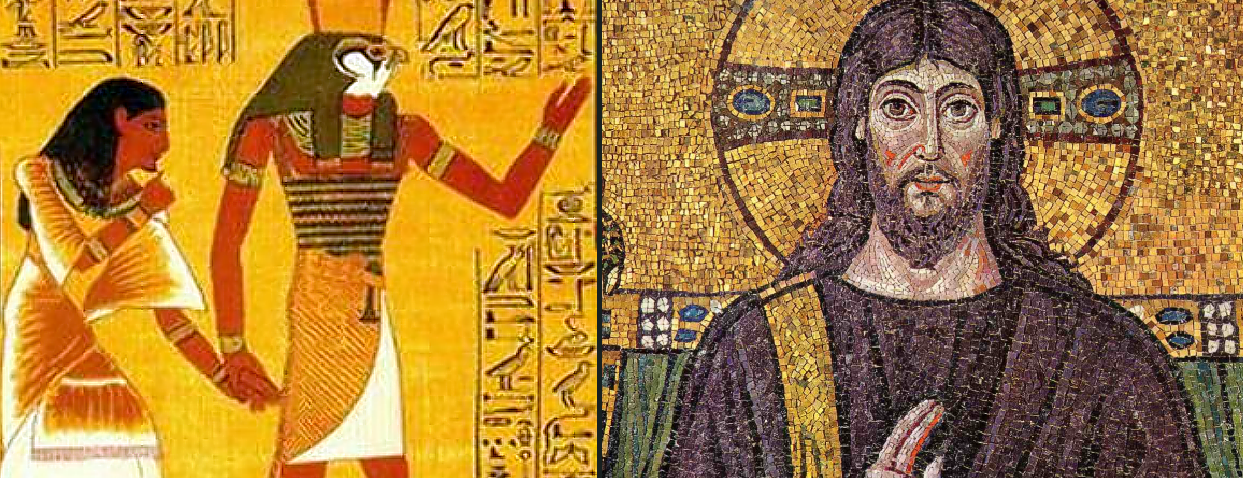He had 12 disciples, performed miracles, exorcized demons, raised someone from the dead, and even walked on water. He was transfigured on a mount and eventually crucified between two thieves. He was buried for three days in a tomb and rose from the dead. According to this ancient religion, this God came to fulfill the Law and was supposed to reign one thousand years. According to those who deny the existence of Jesus, however, this description is of a mythological precursor to Christianity, the Egyptian God named Horus.
Skeptics sometimes use ancient deities like Horus, Mithras or Osiris as examples of dying and rising precursors to Jesus.
They claim the mythology of Jesus was simply borrowed from pre-existing examples such as these. Was Horus really like Jesus in all the ways skeptics often describe him? These similarities are startling. For many Christians especially young believers who encounter this objection while in college similarities such as these cast doubt on the historicity of Jesus. They often merely reflect the expectations and yearnings of ancient people for the God who truly did come to earth. A significant portion of what we just described about Horus is simply false and lacks any Egyptian historical or archeological support whatsoever.
Much of what I described about Horus is simply a reflection of the effort of atheists to make Horus look as much like Jesus as possible. Horus was worshiped principally in two Egyptian cultural centers Bekhdet in the north and Idfu in the south. Little remains at the northern location, but there is still a large and well preserved Ptolemaic temple at Idfu; most of our information about Horus comes from this southern temple.
Horus was usually represented as a falcon. He was the great sky God and the Son of Isis and Osiris.
Navigation menu
Horus was conceived by a virgin mother named Meri, and had a stepfather named Seb Joseph Truth: Horus was NOT conceived of a virgin. For, that bread and a cup of water are placed with certain incantations in the mystic rites of one who is being initiated, you either know or can learn. The devil is the inspirer of the heretics whose work it is to pervert the truth, who with idolatrous mysteries endeavours to imitate the realities of the divine sacraments.
Some he himself sprinkles as though in token of faith and loyalty; he promises forgiveness of sins through baptism; and if my memory does not fail me marks his own soldiers with the sign of Mithra on their foreheads, commemorates an offering of bread, introduces a mock resurrection, and with the sword opens the way to the crown.
- Jesus in comparative mythology - Wikipedia.
- Medikamentös induzierte neurologische und psychiatrische Störungen (German Edition).
- 10 Christ-like Figures Who Pre-Date Jesus.
- .
- Is Jesus Simply a Retelling of the Horus Mythology? | Cold Case Christianity.
- .
- Der Kampf gegen die Geschlechtskrankheiten - Probleme, Lösungen und ihre Umsetzung (German Edition).
Moreover has he not forbidden a second marriage to the supreme priest? He maintains also his virgins and his celibates. According to Ehrman, these writers were ideologically motivated to portray Christianity and Mithraism as similar because they wanted to persuade pagan officials that Christianity was not so different from other religious traditions, so that these officials would realize that there was no reason to single Christians out for persecution.
In late antiquity , early Christians frequently adapted pagan iconography to suit Christian purposes. Early Christians also identified Jesus with the Greek hero Orpheus , [] who was said to have tamed wild beasts with the music of his lyre. Early Christians found it hard to criticize Asclepius because, while their usual tactics were to denounce the absurdity of believing in gods who were merely personifications of nature and to accuse pagan gods of being immoral, [] neither of these could be applied to Asclepius, who was never portrayed as a personification of nature and whose stories were inscrutably moral.
In some depictions from late antiquity, Jesus was shown with the halo of the sun god Sol Invictus.
Jesus in comparative mythology
Christians also may have adapted the iconography of the Egyptian goddess Isis nursing her son Horus and applied it to the Virgin Mary nursing her son Jesus. Byzantine mosaic of Jesus with his head surrounded by a halo c. Sixth-century AD icon of the enthroned Virgin and Child with saints and angels, and the Hand of God above, from Saint Catherine's Monastery , possibly the earliest iconic image of the subject to survive. The Bible never states when Jesus was born, [] [] [] but, in the fourth century AD, Pope Julius I decreed that his birth would be celebrated on 25 December.
Aspects of Jesus's life as recorded in the gospels bear some similarities to various other figures, both historical and mythological. Classical mythology is filled with stories of miraculous births of various kinds, [] [] [] [] but, in most cases of divine offspring from classical mythology, the father is a god who engages in literal sexual intercourse with the mother, a mortal woman, [] [] causing her to give birth to a son who is literally half god and half man.
Another comparable story from Greek mythology describes the conception of the hero Perseus. David Litwa, the authors of the Gospels of Matthew and Luke consciously attempt to avoid portraying Jesus's conception as anything resembling pagan accounts of divine parentage; [] the author of the Gospel of Luke tells a similar story about the conception of John the Baptist in effort to emphasize the Jewish character of Jesus's birth.
Folklorist Alan Dundes has argued that Jesus fits all but five of the twenty-two narrative patterns in the Rank-Raglan mythotype , [] [] and therefore more closely matches the archetype than many of the heroes traditionally cited to support it, such as Jason , Bellerophon , Pelops , Asclepius , Joseph , Elijah , and Siegfried. Wills states that the "hero paradigm in some form does apply to the earliest lives of Jesus", albeit not to the extreme extent that Dundes has argued. The late nineteenth-century Scottish anthropologist Sir James George Frazer wrote extensively about the existence of a "dying-and rising god" archetype in his monumental study of comparative religion The Golden Bough the first edition of which was published in [] [] as well as in later works.
Then, in the middle of the twentieth century, the complete, unabridged, original Sumerian text of Inanna's Descent was finally translated, [] [] revealing that, instead of ending with Dumuzid's resurrection as had long been assumed, the text actually ended with Dumuzid's death. Frazer and others also saw Tammuz's Greek equivalent Adonis as a "dying-and-rising god", [] [] [] despite the fact that he is never described as rising from the dead in any extant Greco-Roman writings [] and the only possible allusions to his supposed resurrection come from late, highly ambiguous statements made by Christian authors.
In the late twentieth century, scholars began to severely criticize the designation of "dying-and-rising god" altogether. Smith concluded in Mircea Eliade 's Encyclopedia of Religion that "The category of dying and rising gods, once a major topic of scholarly investigation, must now be understood to have been largely a misnomer based on imaginative reconstructions and exceedingly late or highly ambiguous texts.
From Wikipedia, the free encyclopedia.

Jesus has been compared to a broad variety of figures from various mythological traditions within the Mediterranean Basin , including in rows from left to right Dionysus , Mithras , Sol Invictus , Osiris , Asclepius , Attis , and Adonis. Jesus , Historicity of Jesus , and Historical Jesus. Mithras rising from the rock National Museum of Romanian History. Mithras born from the rock c. Christian statue of Jesus as the " Good Shepherd " c. Late Roman copy of a fifth-century BC Greek statue showing Hermes , the god of travelers, carrying a ram over his shoulders in his role as Kriophoros the "Ram-Bearer".
Rank-Raglan mythotype and Hero.
10 Christ-like Figures Who Pre-Date Jesus - Listverse
Price , a former fundamentalist apologist turned atheist who says the existence of Jesus cannot be ruled out, but is less probable than non-existence, agrees that his perspective runs against the views of the majority of scholars. I have to say that I do not know any respectable critical scholar who says that any more. Evidence and Argument or Mythicist Myths? Moreover, it has not been produced by anyone or anything with any reasonable relationship to critical scholarship. It belongs to the fantasy lives of people who used to be fundamentalist Christians. They did not believe in critical scholarship then, and they do not do so now.
I cannot find any evidence that any of them have adequate professional qualifications. The point I shall argue below is that, the agreed evidentiary practices of the historians of Yeshua, despite their best efforts, have not been those of sound historical practice". In a later euhemerized retelling of the myth of Pentheus from the third century BC, however, the Greek historian Diodorus Siculus states that Dionysus crossed the Hellespont and "defeated the Thracian forces in battle.
Lycurgus, whom he took prisoner, he blinded, tortured in every conceivable way and finally crucified. Migne, Patrologiae Cursus Completus: I found several websites run by Christians who obviously disputed all claims of any parallels to the life of Jesus. As a non-christian, I am approaching this topic purely as an interested observer. I am assuming half of the people who read this will automatically say the claims are false and the other half will say they are true. The truth I found is that it is difficult to know for sure.
Both went to their temples at the age of twelve, where they are said to have astonished all with their wisdom. Both supposedly fasted in solitude for a long time: Buddha for forty—seven days and Jesus for forty. Both wandered to a fig tree at the conclusion of their fasts. Both were about the same age when they began their public ministry:.
The prince, determined to become such a monk, was led to make the great renunciation. To Buddha, he said: Both strove to establish a kingdom of heaven on earth. Christ and Krishna were called both God and the Son of God. Both were sent from heaven to earth in the form of a man. Both were called Savior, and the second person of the Trinity. A spirit or ghost was their actual father. Krishna and Jesus were of royal descent.
Both were visited at birth by wise men and shepherds, guided by a star. Angels in both cases issued a warning that the local dictator planned to kill the baby and had issued a decree for his assassination.
SHOCK CLAIM: The story of JESUS was 'copied from prior religions to CONTROL the people'
Both Christ and Krishna withdrew to the wilderness as adults, and fasted. Both performed many miracles, including the healing of disease. One of the first miracles that both performed was to make a leper whole. Both selected disciples to spread his teachings.
Both were meek, and merciful.
